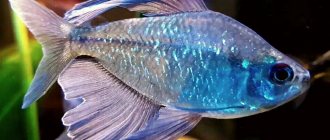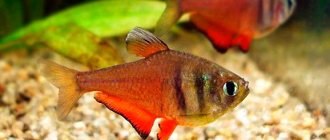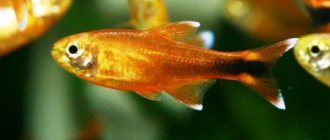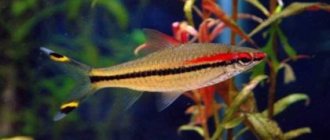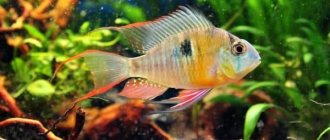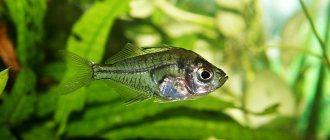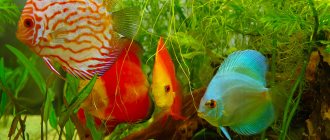Columbia tetra (Hyphessobrycon columbianus) Zarske & Gery, 2002
An unpretentious aquarium fish, it relatively recently became known to aquarists. She quickly won their favor thanks to her bright colors, peacefulness and interesting behavior. Compatible with most other peaceful tropical fish of similar size.
Synonyms
English: Hifessobricon columbia, Sapphire tetra, Blue-red tetra, Colombian red-finned tetra
Etymology
Hyphessobrycon: From Ancient Greek (hyphesson), meaning "smaller in stature", and here used as a prefix, plus the common name Brycon. columbianus: Named after the native country of Colombia.
Family: Characidae Genus: Hyphessobrycon
Range and Habitat
South America: Acandi River basin, Colombia.
Found only in the Acandi River, 6 km downstream from the city of Acandi in the Choco department in northern Colombia, near the border with Panama.
Habitats are small forested streams and tributaries (aquatic and marsh plants, decaying organic matter, branches, etc.) with a slow flow.
Acidification of water occurs from the decomposition of plants. This phenomenon changes the color of the water, which tends to turn brown. In some areas that are particularly rich in organic matter, the water takes on a hue that is characterized as black water.
Description
The dorsal fin is quite high and extends far back. The part of the back located in front of the dorsal fin is often slightly raised with a hump. Some specimens may have a yellow to orange dorsal fin. The head tapers to a rounded mouth containing fairly large teeth and powerful jaws for such a small fish. The large eyes (proportionally these eyes are significantly larger than those of many other species) suggest that these fish are active predators whose keen vision helps both detect prey and avoid potential predators. With a narrow, developed caudal peduncle and a high, sharp-edged caudal fin, it is an active swimmer designed for short bursts at high speed.
The back and upperparts are a slightly iridescent pastel blue, which in good conditions expands downward to cover the entire side. Particularly bright specimens have a bright blue stripe running along the lateral line. The bottom is painted a bright metallic silver, and in certain lighting conditions acts like a mirror, catching the blue color from above and reflecting it; thus, this fish may appear completely blue.
The ventral and caudal fins of this fish make up the red half of the color. Starting at the anterior margin of the anal fin (which is elongated in both sexes), the rays are red in color, intensifying as they move posteriorly. Some individuals have a sort of residual pinkish glow along the body just above the anal fin. The caudal fin (and even the caudal peduncle in some specimens) is completely filled with a fiery bright crimson color. The anal fin is usually edged black, and like the dorsal and caudal fins has a whitish tip.
As with most tropical fish, these colors can be brighter if the fish are in good conditions. Conversely, they will have a blurred or dull color under poor conditions or under stress.
Size:
Maximum standard length 50 - 65 mm.
We select neighbors
First of all, when choosing fish that will live with your Colombian tetra, you should take into account their eating habits. A large amount of feed falls on the ground. You have to clean it daily to prevent it from deteriorating and deteriorating the quality of the water. But the problem can be easily solved if you keep small catfish. Ancistrus or speckled catfish would be a good choice. The first one will clean the glass and decorative items, and the second one will swim along the very bottom, collecting the remains of the meal.
In addition, platies, guppies, neons and other not too large, calm fish will become good neighbors. But they will not get along with barbs or swordtails. Mobile and at the same time quite aggressive fish will turn the life of unfortunate tetras into a real nightmare, chasing and sometimes biting off fins.
At the same time, calm, slow fish would be a bad choice - sometimes tetras like to play with their flock and will cause problems for their neighbors.
Behavior and Compatibility
A generally peaceful species with a lively temperament, making them ideal residents for a well-selected community aquarium. Although this fish is not territorial, it is sometimes aggressive towards other species.
They are probably best kept with similarly sized characins and congeners, small callichtid or loricarid catfish, and medium-sized non-predatory cichlids.
Try purchasing a mixed group of at least 8-10 fish, include other schooling fish for safety, and you will see more natural and peaceful behavior.
Content
- 1 Biological systematization
- 2 Description
- 3 Habitat
- 4 Diet
- 5 Behavior in an aquarium
- 6 Contents
- 7 Spawning and breeding
- 8 Photo gallery
- 9 Sources of information
- 10
- Other names: Ecuadorian Hyphessobrycon, Hyphessobrycon equadoriensis.
- Origin: Central Africa.
- Size: up to 5-6 cm.
- Temperature: 23-28 °C.
- Water parameters: pH 6.0-7.5; hardness 4-18.
- Lighting: dim.
- Behavior: peaceful, active.
- Growth rate: average.
- Content difficulty: low.
Nutrition
Omnivores, in nature they feed on zoo- and phytoplankton, detritus and algae, insect larvae, as well as worms and crustaceans.
In aquariums it can survive on a diet of dry food, but it is best to offer a varied menu, which in this case should contain live and frozen food - bloodworms, coretra, daphnia, brine shrimp, tubifex, etc. Be sure to add dry food containing plant components to your diet.
Feed a variety of foods and the fish will reward you with their best colors and natural behavior.
Possible diseases
In general, tetras are not prone to disease. They usually arise due to injuries received (due to negligence on the part of the aquarist or the fault of aggressive neighbors), as well as unsuitable living conditions.
In addition, fish are quite sensitive to water quality. For example, large amounts of chlorine can burn the gills, leading to death in the most severe cases.
You also need to monitor the quality of the feed. Live bloodworms or tubifex, caught in unfamiliar places or purchased from new sellers, should be treated with a solution of potassium permanganate or methylene blue to destroy parasite eggs and prevent infection from entering the aquarium.
Breeding
Can be bred similarly to other species of this genus.
In good conditions, adults will spawn frequently, and in a biologically mature aquarium, a small number of fry may appear without any intervention on your part.
However, if you want to maximize breeding, a more controlled approach is required and you will need to use a separate aquarium.
Columbian tetra (Hyphessobrycon columbianus) spawning aquarium options
Spawning aquarium about 20 liters. It should be dimly lit and contain several tufts of small-leaved plants such as java moss to give the fish a place to lay their eggs. Alternatively, you could cover the bottom of the aquarium with some kind of netting. The cell must be large enough for the eggs to fall through, but small enough that the producers cannot reach it. You can also use common plastic grass mats that work well.
The water itself should have a slightly acidic to neutral pH and a temperature in the upper range indicated above.
A sponge air filter or air stone(s) should also be installed to ensure oxygenation and water movement.
Before spawning, it is best to separate males and females by feeding them generously. When the spawners are well prepared, one pair or group of one or two males and several females can be placed in each spawning tank and left to spawn until the eggs are found (usually the next morning).
Spawning usually lasts 2–4 hours (spawners are removed immediately after spawning) and a mature female in good condition can lay up to 2000 eggs, which usually hatch in 24–36 hours, after which the larvae still have a large yolk sac.
Starter food for the first few days is ciliates or a special dry food fairly small (5-50 microns) until they are large enough to accept microworms, brine shrimp and cyclops nauplii.
In favorable conditions, life expectancy is about 5 years.
Biological systematization
Latin name: Hyphessobrycon equadoriensis (Eigemann, Henn & Wilson, 1914)
Synonyms: Astynax spec.
(Latin), sapphire tetra, Ecuadorian tetra, Colombian tetra, Blauroten Kolumbiensalmler (German)
- Order Characiformes
;
Family American tetras ( Characidae
);
Subfamily Incertae sedis is a group of uncertain subfamily status. Genus Hyphessobrycon
Durbin, 1908 Conventional
taxonomy group Bifasciatus
It is considered a relatively close relative of the cave blind fish, well known to aquarists [1]
Notes
This species was misidentified as H. ecuadorensis from western Ecuador several years before the description of H. columbianus in 2002, the latter being commonly confused with the former.
Within the genus, it appears to be most closely related to the Costa Rican endemic H. savagei Bussing, 1967, but differs in a number of characters, namely: the main body color is silver with iridescent blue in the upper part of both males and females ( compared to silver with iridescent blue only in the anal area in males); caudal and anal fins are bright blood red, pelvic fins are transparent to light orange (in contrast to the anal and pelvic fins are blood red, the caudal fin is orange); absence of a significant change in the color pattern of fish in the pre-spawning state (compared to a pronounced increase in the color pattern).
Hyphessobrycon savagei endemic to Costa Rica Bussing, 1967
H. panamensis lives in Costa Rica, Panama and possibly Colombia
H. panamensis, found in Costa Rica, Panama and possibly Colombia, is also comparable to H. columbianus, but they can be distinguished as follows: the male's dorsal fin is slightly longer than that of the female (versus significantly longer); the main body color is silver with iridescent blue in the upper part (compared to silver-gray with sometimes a dark longitudinal stripe from the second spot to the base of the caudal fin; no significant change in color pattern in fish in the pre-spawning state (compared to increased color).
Reproduction
In tetras, it is usually easy to distinguish the female from the male: she is larger, rounder and pot-bellied, and less brightly colored. Breeding tetras at home is possible, but requires some experience in fish breeding. In a community aquarium, as a rule, eggs and fry do not survive. Tetras' parental instincts are underdeveloped; they can easily eat their own eggs. A spawning tank is required.
